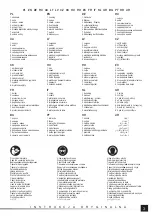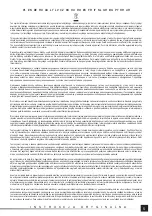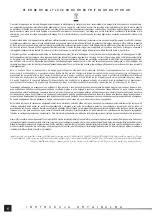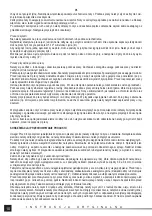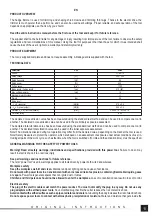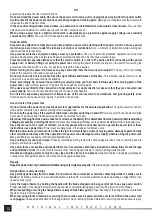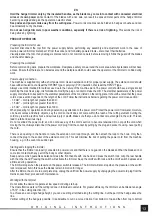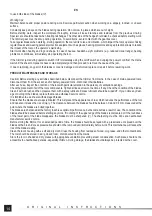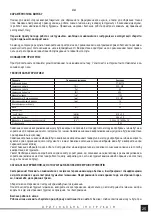
12
EN
O R I G I N A L I N S T R U C T I O N S
power tool increases the risk of electric shock.
Do not overload the power cable. Do not use the power cord to carry, pull or unplug the power plug from the power outlet.
Avoid contact of the power cable with heat, oils, sharp edges and moving parts.
Damage or entanglement of the power cord
increases the risk of electric shock.
In the case of working outside closed rooms, use extension cords intended for work outside closed rooms.
The use of an
extension cord adapted for outdoor use reduces the risk of electric shock.
When using a power tool in a humid environment is unavoidable as a protection against supply voltage use a residual
current device (RCD).
The use of RCD reduces the risk of electric shock.
Personal safety
Stay alert, pay attention to what you do and keep common sense while working with the power tool. Do not use a power
tool when you are tired or under the in
fl
uence of alcohol or medication.
Even a moment of inattention while working can
lead to serious personal injury.
Use personal protective equipment. Always wear eye protection.
The use of personal protective equipment such as dust
masks, anti-slip safety shoes, helmets and hearing protection reduce the risk of serious personal injury.
Prevent accidental operation. Make sure that the electric switch is in the “o
ff
” position before connecting to the power
supply and / or battery, lifting or moving the power tool.
Moving the power tool with the
fi
nger on the switch or powering the
power tool, when the switch is in the “on” position can lead to serious injuries.
Before turning on the power tool remove any keys and other tools that were used to adjust it.
The key left on the rotating
parts of the power tool can lead to serious injuries.
Do not reach and do not lean too far. Keep the right attitude and balance all the time.
This will allow easier control over the
power tool in case of unexpected work situations.
Dress accordingly. Do not wear loose clothing or jewelry. Keep your hair and clothing away from moving parts of the
power tool.
Loose clothing, jewelry or long hair can be caught by moving parts.
If the devices are
fi
tted for the connection of dust extraction or dust collection, make sure that they are connected and
used properly.
The use of dust extraction reduces the risk of dust hazards.
Do not let the experience acquired from frequent use of the tool resulted in carelessness and ignoring safety rules.
Carefree action can cause serious injuries in a fraction of a second.
Use and care of the power tool
Do not overload the power tool. Use the power tool appropriate for the selected application.
The right power tool will pro-
vide a better and safer job if used according to the designed load.
Do not use the power tool, if the electric switch does not allow switching on and o
ff
.
Power tool, which cannot be controlled
by means of a power switch is dangerous and must be returned for repair.
Disconnect the plug from the power socket and / or remove the battery if it is detachable from the power tool before adjusting,
changing accessories or storing the tool.
Such preventive measures will allow you to avoid accidentally turning on the power tool.
Keep the tool out of the reach of children, do not let people who do not know how to operate the power tool or these
instructions use a power tool.
Power tools are dangerous in the hands of untrained users.
Maintain power tools and accessories. Check the tool for mismatches or jams of moving parts, damage to parts and any
other conditions that may a
ff
ect the operation of the power tool. Damage must be repaired before using the power tool.
Many accidents are caused by incorrectly maintained tools.
Keep cutting tools sharp and clean.
Properly maintained cutting tools with sharp edges are less prone to jamming and are
easier to control when working.
Use power tools, accessories and inserted tools etc. in accordance with these instructions, taking into account the type
and conditions of work.
The use of tools for work other than designed is likely to result in a dangerous situation.
Handles and gripping surfaces must be dry, clean and free from oil and grease.
Slippery handles and gripping surfaces do
not allow for safe operation and control of the tool in dangerous situations.
Repairs
Repair the power tool only in authorized facilities using only original spare parts.
This ensures proper operation safety of the power tool
Hedge trimmer safety warnings
Keep all body parts away from the blade. Do not remove the cut material or hold the cut material while the blades are in
motion.
The blades continue to move after the switch is turned o
ff
. A moment’s inattention when operating a hedge trimmer can
cause serious injury.
Carry the hedge trimmer by holding the handle with the blade stopped and being careful not to use any power switch.
Proper handling of the hedge trimmer will reduce the risk of unintentional triggering and resulting injury from the blades.
When transporting or storing the hedge trimmer always
fi
t the blade guard.
Proper handling of the hedge trimmer will reduce
the risk of injury from the blades.
When removing blocked material or servicing the tool, make sure all power switches are turned o
ff
and the power cord
is unplugged.
Unexpected activation of the hedge trimmer when removing blocked material or servicing can cause serious injury.
Summary of Contents for YT-84770
Page 21: ...21 RU residual current device RCD...
Page 22: ...22 RU H05RNF H05VVF...
Page 23: ...23 RU 1 0 2 40 1 5 2 60 2 5 2 100 II ee 5 10O III IV...
Page 24: ...24 RU 0 2 0 4 V...
Page 26: ...26 UA residual current device RCD...
Page 27: ...27 UA H05RNF H05VVF...
Page 28: ...28 UA 1 0 2 40 1 5 2 60 2 5 2 100 II 5 10O III IV...
Page 29: ...29 UA 0 2 0 4 V...
Page 74: ...74 GR RCD RCD...
Page 75: ...75 GR o H05RNF...
Page 76: ...76 GR PVC H05VVF 1 0 mm2 40 m 1 5 mm2 60 m 2 5 mm2 100 m II 5 10O III IV...
Page 77: ...77 GR 0 2 0 4 mm V...
Page 79: ...79 BG RCD RCD...
Page 80: ...80 BG H05RNF PVC H05VVF 1 0 mm2 40 m...
Page 81: ...81 BG 1 5 mm2 60 m 2 5 mm2 100 m II 5 10O III IV...
Page 82: ...82 BG 0 2 0 4 mm V...
Page 91: ...91 AR YT LwA K LwA K ah K IPX...
Page 92: ...92 AR RCD DCR H RNF H VVF PVC...
Page 93: ...93 AR II III IV V...



